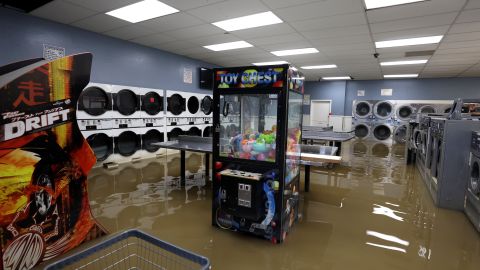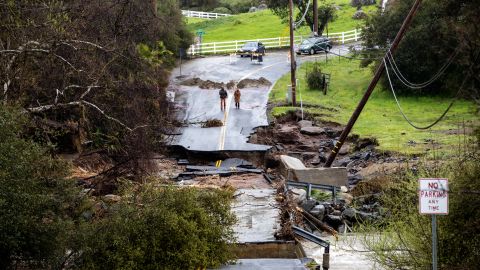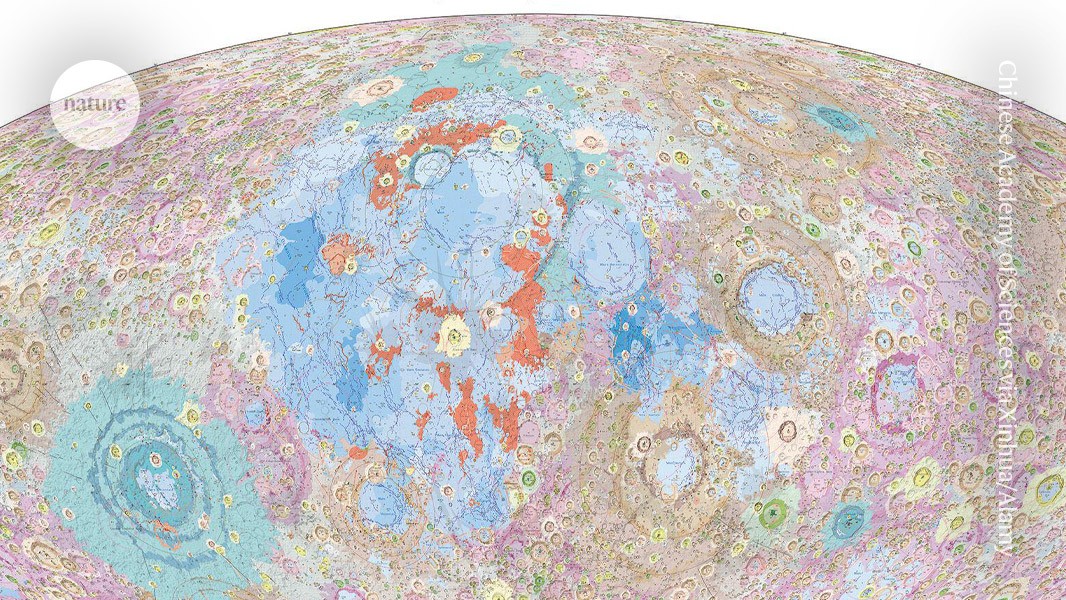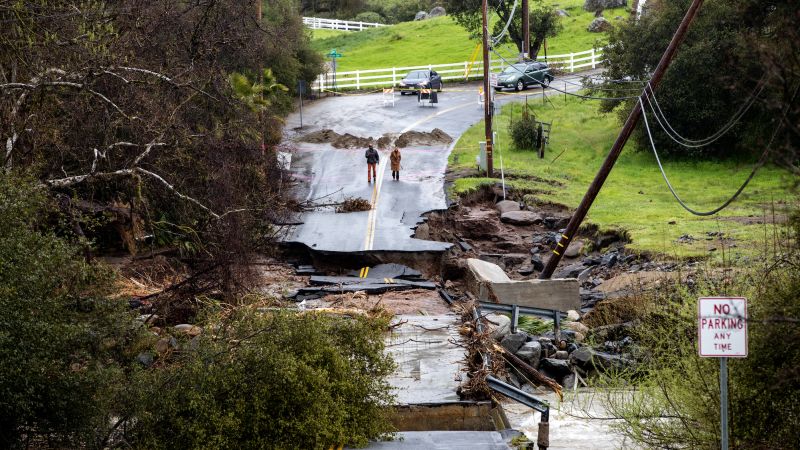CNN
—
Hundreds of thousands in flood-ravaged California are without power and hundreds of people are in shelters as the latest atmospheric river sweeps though the state with ferocious hurricane-force winds and drenches already flooded neighborhoods.
The wind was so strong it is suspected to have sent glass falling from a downtown San Francisco high-rise building and toppled trees and power lines across the state.
The San Francisco Bay area’s public transit system, known as BART, was also being heavily impacted by the storm Tuesday. “Most of our impacts on service have been due to high winds toppling trees and fallen branches entering our trackway,” BART spokeswoman Cheryl Stalter tells CNN.
Top wind gusts of 74 mph were measured at San Francisco Airport, 97 mph at Santa Clara County’s Loma Prieta and 93 mph at Alameda County’s Mines Tower, according to the National Weather Service.
The combination of strong winds and heavy rain also left over 270,500 homes and businesses without power across California, many of them in Santa Clara County south of San Francisco, according to PowerOutage.US.
About 30 million people across California remain under flood alerts as the storm wallops the state with repeated rounds of heavy rain and mountain snow, with rain pummeling already saturated land, threatening more dangerous floods and mudslides.
California Gov. Gavin Newsom expanded a state of emergency to cover 43 of the state’s 58 counties Tuesday night as high winds and intense rain wrought havoc in the state.
This is the 11th atmospheric river – a long, narrow band of moisture that can carry saturated air thousands of miles like a fire hose – to inundate California this winter season, arriving on the heels of another storm that hit central California particularly hard.
The state will get just a few days of reprieve after this storm tapers off Wednesday before yet another atmospheric river arrives next week, the National Weather Service warns.
The back-to-back storms have forced many people out of their homes as officials worried about mudslides from fire-scarred areas, overflowing rivers and dangerous road conditions.
More than 71,600 people were under evacuation warnings and nearly another 27,000 were under evacuation orders across the state as of Tuesday morning, California Governor’s Office of Emergency Services spokesman Gustavo Ortiz told CNN.
Statewide, hundreds of people were taking refuge in dozens of shelters across multiple counties Tuesday, according to state officials.
Evacuation alerts remain in several counties Wednesday, including for those near the swollen Salinas and Pajaro rivers in Monterey County. To the south, residents near wildfire burn scars in Los Angeles County were under evacuation warnings.
In Placer County, a mudslide Tuesday evening caused major damage to a home in Colfax, prompting an evacuation warning for other homes, according to the CAL FIRE Nevada-Yuba-Placer Unit.
The heaviest rain is continuing to shift southward and will impact areas from San Luis Obispo to Los Angeles and San Diego through early Wednesday morning.

Many of those who’ve had to leave their homes are from Monterey County, where crews are racing to repair a breach in a river levee that sent water rushing into a nearby community of Pajaro overnight Friday.
More than 2,000 people have also been evacuated from the Pajaro area, Monterey County Sheriff Tina Nieto said.
Water from another breach in the area eroded nearby bridges and flowed into Highway 1 – a major highway that had to be shuttered, Monterey County officials said.
Video from Pajaro shows the community still looking like a lake, with floodwater reaching all the way to cars’ doorhandles. More than 239 people have been rescued in the Pajaro area, with crews using high-water vehicles and boats to pull people from floodwater, Nieto said.
One Pajaro resident drove to the outskirts of town to see her home for the first time since evacuating Saturday morning. She found the bottom level of her home and the garage under water, she told CNN affiliate KSBW.
“I want to cry but what’s crying going to do? It’s just sad, so sad,” Michelle Keith told KSBW.
Another Pajaro resident, Ruth Ruiz, hasn’t been able to return home since she left in hurry before dawn Saturday and was worried about how long it’ll take to get back to normal life after evacuation orders are lifted.
“We don’t really have a plan. We’re just taking it day by day. But we have a feeling it’s going to be months before even insurance can cover any damages,” Ruiz told CNN affiliate KPIX.
Crews were making progress filling the gaps in the levee Tuesday, racing to stem the flow of water from the breach.
“We caught a little bit of a break, the modeling changed from last night to this morning as we talked about,” Sheriff Nieto said. “Some of the precipitation we thought was going to be dumped into Monterey County has shifted south of us towards Paso Robles and into the Santa Barbara area.”

California has been hit with an unrelenting barrage of atmospheric rivers that brought deadly flooding to the state this winter season, and this latest one won’t be the last.
Once this storm system moves out Wednesday, the state will get a few days of relief before another atmospheric river arrives, the National Weather Service said.
Heavy rain, melting snowpack, saturated soils and swollen streams may lead to prolonged flooding concerns and the potential for shallow landslides in some areas of California,” the Weather Service said.
More rain, snow, high winds and flooding could be on the forecast for much of California from March 21 to March 23, forecasters said.
Atmospheric rivers are typically 250 to 375 miles wide and can stretch more than a thousand miles long, the National Oceanic and Atmospheric Administration says.
While they’re an important source of rainfall for the West, atmospheric rivers can create conditions similar to those of hurricanes when they pass over land, according to NOAA.
Due to the effects of global warming, scientists believe atmospheric rivers can become more intense as the air temperatures increase.
Atmospheric rivers will be “significantly longer and wider than the ones we observe today, leading to more frequent atmospheric river conditions in affected areas,” a NASA-led study found.







More News
Maurizio Cattelan’s Got a Gun Show
What to Know About Venice’s Fees for Day Trips
U.S. Economy Grew at 1.6% Rate in First Quarter Slowdown